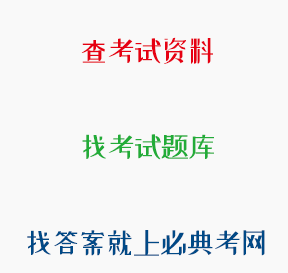正确答案: B
乙
题目:甲.乙、丙三人中,只有一个会打篮球。甲说:"我会",乙说:"我不会",丙说:"甲不会"。如果这三句话,只有一句是真的,那么会打篮球的是( )。
解析:分析题干中的三句话可知,甲和丙说的话是矛盾的,那么甲和丙之间必有一个人说的是真的,根据题干中"只有一句是真的",可以推出乙说的话必为假,则乙会打篮球,再根据"只有一个会打篮球",故选择B项。
查看原题 查看所有试题
学习资料的答案和解析:
[单选题]婴幼儿在与成人的交往中,学会区分"你…'我…'他"。根据奥苏伯尔的学习分类,这里发生的学习实质是( )。
概念学习
解析:能正确使用三个人称代词,说明儿童能对三个代词所指称的事物正确归类,即儿童以概念形式掌握了"你我他",属于奥苏伯尔的概念学习。
[多选题]德育过程就是个体社会化和社会规范个体化的统一过程。( )
解析:德育过程是以提升受教育者的品德水平为目标,教育者与受教育者共同参与的教育活动过程。德育过程从本质上说就是个体社会化与社会规范个体化的统一过程。德育过程的矛盾是教育者提出的德育目标与受教育者现有水平之间的矛盾。
[单选题]请阅读 Passage 1,完成1~5小题。
Passage 1
In the field of psychology,there has long been a certain haziness surrounding the definition of creativity,an I-know-it-when-I-see-it attitude that has eluded a precise formulation.During our conversation,Mark Beeman,a cognitive neuroscientist at Northwestern University,told me that he used to be reluctant to tell people what his area of study was,for fear of being dismissed or misunderstood.What,for instance,crosses your mind when you think of creativity? Well,we know that someone is creative if he produces new things or has new ideas.And yet,as John Kounios,a psychologist at Drexel University who collaborates frequently with Beeman,points out,that view is wrong,or at least not entirely right."Creativity is the process,not the product," he says.
To illustrate,Beeman offers an example.Imagine someone who has never used or seen a paperclip and is struggling to keep a bunch ofpapers together.Then the person comes up with a new way of bending a stiff wire to hold the papers in place. "That was very creative," Beeman says.On the flip side,if someone works in a new field-Beeman gives the example of nanotechnology-anything that he produces may be considered inherently "creative".But was the act of producing it actually creative? As Beeman put it,"Not all artists are creative.And some accountants are very creative."
Insight,however,has proved less difficult to define and to study.Because it arrives at a specific moment in time,you can isolate it,examine it,and analyze its characteristics."Insight is only one part of creativity," Beeman says."But we can measure it.We have a temporal marker that something just happened in the brain.I'd never say that's all of creativity,but it's a central, identifiable component." When scientists examine insight in the lab.they are looking at what types of attention and thought processes lead to that moment of synthesis: If you are trying to facilitate
a breakthrough,are there methods you can use that help? If you feel stuck on a problem,are there tricks to get you through?
In a recent study,Beeman and Kounios followed people's gazes as they attempted to solve what's called the remote-associates test,in which the subject is given a series of words,like "pine" "crab" and "sauce" and has to think of a single word that can logically be paired with all of them.They wanted to see if the direction of a person's eyes and her rate ofblinking could shed light on her approach and on her likelihood of success.It turned out that if the subject looked directly at a word and focused on it-that is,blinked less frequently,signaling a higher degree of close attention-she was more likely to be thinking in an analytical,convergent fashion,going through possibilities that made sense and systematically discarding those that didn't.If she looked at "pine" say,she might.be thinking of words like "tree" "cone" and "needle" ,then testing each option to see if it fit with the other words.When the subject stopped looking at any specific worD.either by moving her eyes or by blinking,she was more likely to think of broader,more abstract associations.That is a more insight-oriented approach."You need to learn not just to stare but to look outside your focus," Beeman says.(The solution to this remote-associates test: "apple" .)
As it turns out,by simple following someone's eyes and measuring her blinks and fixation times,Beeman's group can predict how someone will likely solve a problem and when she is nearing that solution.That's an important consideration for would-be creative minds: it helps us understand how distinct patterns of attention may contribute to certain kinds ofinsights.
What is the best title for this passage?
Where Do Creativity Moments Come?
解析:主旨题。文章前两段主要讲了creativity的定义。第三段指出insight是creativity的核心组成部分;虽然creativity不容易理解,但insight比较容易定义和研究。第四段描述了一个实验,实验目的是发现attention和insight之间的关系。第五段指出实验结果,即不同类型的attention能够影响insight,这给了想拥有创造力的人( would-be creative minds) -个重大的启示。由此可以推断,attention能够影响insight,从而产生creativity。可见文章从探讨creativity的定义,到研究insight,归根到底是想发现怎样成为有创造力的人。D项“Where Do Creativity Moments Come?”作为本文的标题最恰当。

 川公网安备 51012202001360号
川公网安备 51012202001360号